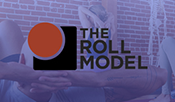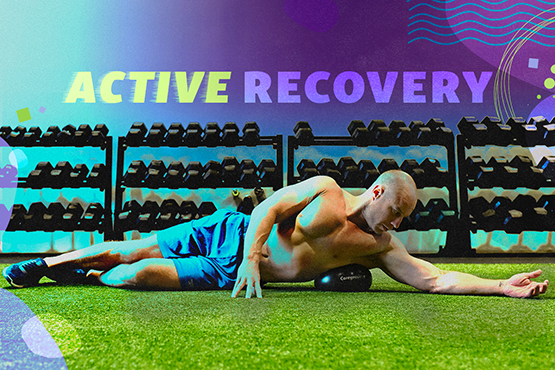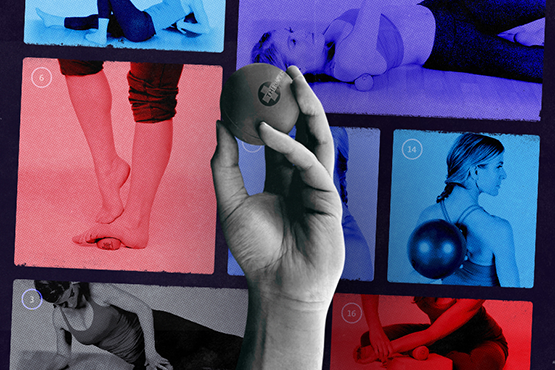
As someone who has suffered terribly from a crippling case of sciatica in the recent past I felt compelled to get to know the culprit in order to better understand the crime. The piriformis muscle is the most powerful player in external rotation of the leg, particularly in classical ballet. In addition, the piriformis is responsible for abducting the femur (lifting the leg away from the midline) while the hip is in flexion, an important function to transfer one’s weight into the opposite leg while walking. It lies beneath the gluteus maximus, nestled in with its counterparts in external rotation known as the “deep six.” The shape of the piriformis resembles a pyramid, its namesake.

What sets the piriformis apart from its fellow external rotators is that it lives above the sciatic nerve, the largest nerve in the body, instead of beneath it. In the event that the muscle becomes inflamed, goes into spasm, or is chronically shortened, undue pressure is put upon the sciatic nerve that can result in what is commonly thought to be sciatica but is actually piriformis syndrome. To make matters worse, in approximately 15-30% of the population the sciatic nerve actually passes through the piriformis, dividing it into two parts and increasing the chance of piriformis syndrome. Women are also believed to be at a greater risk, due to the steeper degree at which the femurs angle in to the midline from the acetabulum in female hips.
According to Gabe Mirkin, M.D., in his article aptly titled Pain in the Butt: Piriformis Syndrome: “You probably shouldn’t do any exercise that causes you to bend at the hip while keeping your knees straight, because this will stretch the sciatic nerve.” Ah-hem, Uttanasana 108 times a day, anyone? Runners and cyclists are also good candidates for this condition due to the repetitive contraction and release of the piriformis muscles while propelling them forward through space. Sitting at a desk or in a car with the legs apart and externally rotated are also situations that would cause contraction in the piriformis for extended periods of time, irritating to most of us as well as the sciatic nerve.
In my research on the piriformis I came across an amazing and moving article that shed a lot of light on my conundrum. In How To Get Rid of That Pain In Your Butt by Dr. Clay Hyght, he discusses how common it is to associate symptoms of sciatica with disc herniation, but that it may not be the primary cause at all. Apparently about 50% of people over 30 have herniated disks but don’t know it, so an MRI is likely to find one. The shots, the surgery, the money, the possible addiction to powerful pain pills, and time it takes to recover, still might not take care of the problem if it is, in fact, the pesky piriformis muscle. Needless to say I’m glad I trusted my instincts on that one, Wahe Guru!
Before even considering surgery or other invasive treatments for prolonged sciatica, get on a steady regimen of deep, therapeutic massage and physical therapy with a body worker familiar with the elusive piriformis syndrome. Therapeutic yoga stretches and strengthening exercises for the abdominals, hip-flexors, and pelvic floor are also recommended as piriformis syndrome exercises and treatment, since they might help to take some of the workload off the poor piriformis. An old fashioned dose of R & R wouldn’t hurt either. Using these self-care techniques can help others, like myself, to finally establish peace in the piriformis.
Read part 2 of this article about the Pesky Piriformis.
Learn about Yoga Tune Up at home.
Watch our Free 5-Minute Quickfix: Hips Video













So many people suffer from sciatica and it can be challenging to find the source of the pain. But knowing the source of the pain helps to find the solutions for easing and relief. The pain can be intense and debilitating, so many will do anything to find relief.
Knowing if pirifromis syndrome is the culprit can set someone on an appropriate track for healing via bodywork, rolling using Tune Up methods, and strength building. I’m looking forward to reading part 2 of this article as well as some of the articles mentioned. Thank you!
Thanks for this article! It is so common to hear about the sciatic nerve, but too often have forgotten the real culprit: piriformis. Our sedentary lives today do nothing to balance ourselves. Fortunately, balls and yoga can relieve these symptoms. We have power over our healt!
Thank you for shedding more light on the piriformis ‘ role in aggravating the sciatic nerve. As someone who deals with chronic sciatica, I’ve learned that not everything always stems from something pinched in my lower back and have found that addressing the piriformis has greatly helped.
Thank you for sharing Kate, I had already heard that it is very common to confuse sciatica pain with piriformis syndrome, but I was not sure how it has to do with each other in an anatomical way. I also had no idea that the symptoms of sciatica can be confused with herniated disc problems, which is very common in the population. Unfortunately you go to the doctor and then they want to operate you or they give you pain relievers so strong that they basically keep you sedated and many times this only relieves the symptoms and not the root of the problem. Kate recommends getting deep therapeutic massage and stretching and therapeutic yoga stretching of the abdomen, hip flexors and pelvic floor before taking medication or exposing yourself to major surgery.
When clients tell us they have sciatica its usually piriformis syndrome! There is so much to be done to help!
Love this blog! My father inlaw was able to rid his dx “sciatica” through YTU and rolling out daily at 65 years old!
Great article and good info on the piriforme. I refused surgery and choose yoga!
Thank you for such an informative article and differentiating piriformis syndrome and sciatica. I’ve been a recipient of sciatic pain due to a possible herniated disc and was prescribed a lot of stretching but no strengthening work; it’s great that you’ve highlighted this; thank you.
Kate, Thank you so much for this very informative article. Most of people who does not have this kind of information will be suffering with pain for many years. Sadly medical doctors can’t do much to help remove the cause of sciatica.
I myself had several years of sciatica problem from rigorous yoga practice. For me, 10 Rolfing sessions completely fix my problem, which was lordosis(sway back) causing sciatica pain. Knowledge is a power and so as self care is a power. Now I use Alpha Balls on my back, especially on Quadratus Lumborum from the side and some Piriformis at the very beginning sign of tingling pain, and just few several minuets rolling takes care of it!
Hi Kate, I read your article on Sciatica. I have a fiend who is suffering from the same pain and was baller dancer. Would you be able to help teach some yoga tune up balls excercises and the studio you teach? I have already given her Totes yoga tube up balls
Since I’ve never suffered for sciatica, this was very helpful… I have a lot of students that do. Good little tricks and things to think about. If the student know they have herniated disks, do these recommendations still apply?
It was a good reminder to not overdo any pose like uttanasana especially if you have sciatica. It was also refreshing to read about strengthening other muscle groups like the abdominals, hip flexors and pelvic floor to take some of the imbalance off the piriformis.
I have suffered with Piriformis syndrome. Like you said my MRI showed two bulging disks, yet that wasn’t the problem. I am in that small percentage that Sciatic nerve passes through my piriformis muscle. At the time I didn’t know about YTU. Now I have a few clients that have Piriformis syndrome. I have found using the Yoga Tune Up therapy balls to have my clients aid their own bodies to heal. Also after a long trip in the car the YTU therapy balls are extremely helpful especially in my hip area to recover.
Thank you for this informative article. I teach therapeutics and try to educate my students about the piriformis muscle. So many students I encounter suffer from sciatica pain but don’t go to the doctor, so it becomes challenging to know where their pain is actually stemming from. I’ve found so many YTU and therapeutic applications that can address these areas so they can make it through a self care/therapeutic yoga practice that does not make their condition worse. So grateful the YTU blog, it’s nice to have so many resources available to us. Thank you again!
I am guilty for self diagnosing myself with sciatica, when I probably just suffer from piriformis syndrome. Thank you for all this information. I will start with corrective exercises and YTU massage balls immediately. It is time to knead that “pesky piriformis”.
In Pilates a great deal of time is spent rolling up and down the spine—vertebra by vertebra. Flat back forward fold is a modification for practitioners with issues such as osteoporosis—or to simply vary the exercise. I now understand why—when I’ve been in yoga classes that exclude spinal flexion—my back feels crunchy. I’ve noticed my favorite yoga instructors cue slight bend of the knees going into or out of forward fold—or they vary the motion—perhaps forward fold down—roll up and vice versa. This is the first time I’ve heard of over-stretching the sciatic nerve by bending at the hip with straight knees. Good to know to keep myself and students safe from that “pesky” nerve. I’ve noticed practitioners assume the problem is due to nerve running through piriformis when it may be caused by their form.
Thank you for pointing out that such a large percentage of our over 30 population lives with asymptomatic herniated discs. One of my friends confided that she suffered with sciatica for years but resisted her doctor’s suggestions that she take steroid shots, and submit to a slew of radiating diagnostics, possibly leading to a surgical solution. I suspected that the piriformis was to blame because I too suffered for years before discovering the culprit. After two days of pigeon pose, she was pain free. Amazing. Wouldn’t it be great for doctors if Yoga Tune Up® training were a part of medical school training. Happier doctors, self-aware doctors, fewer invasive solutions.
The home run point of this article is really that surgery shouldn’t be the go-to option for resolving issues of pain in the body that so many people think it is. I’m so thankful for everything I’ve learned about the body and how the YTU Therapy balls can help mitigate and even resolve the aches and pains and twinges that send people running to their doctor, only to receive a vague diagnosis and prescription for pain medication. The issue is never resolved, gets worse, and expensive surgeries get scheduled. Which in turn can cause further aches and pains and twinges, and the vicious circle repeats. I feel so privileged to have received all this knowledge about self-massage and self-care through Yoga Tune Up ® and the Therapy balls and am really looking forward to sharing it with others.
Great information to keep in mind. the other common reference that I have heard is that you should lengthen the hamstrings to help sciatic, I would probably pass on that piece of information now if I was told that.
So many people in my world are complaining of sciatica these days. When researching the causes of sciatica in preparation for a class I was teaching on it, I confused myself more! It seems that the most common cause of sciatica is a tight, short piriformis, followed by a herniated disk. However, for us yogis I believe the piriformis is more likely to be over-stretched (too many hipflexion/knee extension poses). Can a long or weak piriformis still be the cause of sciatic pain? If so, deep massage and ball rolling would probably be substituted by strengthening, yes? How does one assess the culprit?
[…] another. In other words, your hip flexors could be very tight, yet you might naturally possess more external rotation in your hips than the person next to you making certain poses like pigeon pose more accessible and poses like […]
Hi Kate. Thanks for the great article about the piriformis. As of late I have started to hear a lot of complaints from my yoga students due to what they call ‘sciatica’ when many have not actually visited a doctor for correct diagnosis. Your article has further deepened my knowledge of the ‘deep six’ and the reminder of what not to do (forward bends in knee flexion) and what to do (strengthening the abs, hip flexors and pelvic floor) and of course, get those Yoga Tune Up Balls out!
I have a hockey-player/technical analyst coworker that has a very unhappy sciatic nerve and I thought of him when I saw the title of your article. Thanks for making a great case of what might very well be piriformis syndrome. I’ll be forwarding him the link to get here and, hopefully, he can get rid of his aches in pain because of it.
Thanks
Nikola
Great information. Knowing that an aggrevated piriformis can present as sciatica will help me offer potential relief to one of my newer students who indicated she suffers from sciatica. Some work with the yoga tune up balls should help and bring some awareness to this “pain in the butt” muscle.
Great article on the piriformis. I love the pyramid analogy. I hadn’t heard that one before. i have a student who suffers from sciatica and although I have done a fair bit of research on both sciatic and piriformis disease, it was good to be remind of what not to do (forward bends) and what to do (strengthening the abs, hip flexors and pelvic floor. I have also started doing some Restorative Yoga on her to induce deep relaxation 🙂
Thanks for the very informative article. How interesting that 15-30% of the population has their sciatic nerve passing through the piriformis AND women are more likely to suffer. I’m wondering if the steeper angle of the femur from the acetabulum is also called the “Q Angle”?
Thanks for the great article! After having studied and performed ballet for many years (all in external rotation of the leg) I am now curious if I have ever suffered from piriformis syndrome. I also found it very helpful that you described the shape of the piriformis like a pyramid, its a good visualization to explain to people especially because it is beneath gluteus maximus.
“I have sciatica”- I hear this statement almost every week when I teach my classes and ask anyone if they have injuries or conditions prior to starting class. I started reading about what exactly sciatica was and how I could respond to the student who would tell me this. Thanks for an accessible article that I can add to my research and make me a more well-rounded teacher.
Recently, I have been rolling out my piriformis and flutes due to sacrum issues, etc. I cannot believe how much it is helping to get in through the glutes and release the tension that I literally sit on all day:)
Piriformis used to cause me much pain. I used to call it the dragon in my hip. It took about a year to find the trick to making mine happy. This was before I started using therapy balls but now if the dragon hiccups I am on the floor rolling.
Thanks so much for sharing your research. I have a client suffering from lingering pain in her piriformis. She sits all day. It may very well be that she is sitting with her thighs externally rotated for many hours a day. Will do some assesments next time we meet to see if her inner thighs are weak making her compensate with her external rotators. Thanks!
Thanks, Kate! Very helpful as I have this syndrome, too. The foam roller is my friend. Hope you’re well 🙂
[…] Tune Up® Blog « The Pesky Piriformis Freedom For Our Feet: Healing and Preventing Plantar Fasciitis […]
I wonder how much of sciatica is caused by (or greatly exacerbated by) an imbalance in the hamstrings?I say this because if I am going to experience sciatica symptoms it is most likely going to happen when I’m sitting on an airplane on a long trip after a few days of too little attention to my physical well-being. Often there no time for yoga or exercise in the final days leading up to a long trip. Then a long drive to the airport in the wee hours of the morning, and not enough sleep. In these instances, a well-placed Miracle Ball between my thigh and my airplane seat can be guaranteed to bring pretty close to instant relief.
Musing on the mechanics of this I am reminded that the long head of the biceps femoris assists in external rotation of the hip. Maybe releasing that inspires the Piriformis to let go? Or maybe one hamstring is tighter than the other (most certainly true in my case) throwing the entire pelvis into misalignment so that the Piriformis finds itself tightening in an effort to balance that out? Then when the excessive hamstring pressure is removed the Piriformis can finally relax?
Hmmm! I’m inspired to observe more carefully next time!
Kate-thanks for this! I haven’t experienced this pain while practicing, but have felt it while driving and working at my desk. I hadn’t heard of piriformis, but will certainly mention this to my yoga teacher, chiropractor and massage therapist. I completely agree that self-preventative care is the best approach.
I too have suffer from yoga butt! A tight periiformis is definitely one of the culprits of this injury. I am now always mindful when I do any forward bends, making sure I always engage my quadraceps–the synergist muscles.
Great blog Kate, thanks for posting. Yoga Butt! Cause that’s what happens when we have tight hammies and are bending over at the hips hundreds of times and keeping our knees straight. That and slight possibility of over tugging on nerve endings in spine can lead to severe nerve damage over time. After a few months of working on my hamstrings I kept on wondering why my Yoga poses weren’t able to eliminate piriformis. I tried everything, in the end it was some trigger point self massage that took my yoga pain in the butt right out within two weeks of daily periodic massages. Haven’t had it since and now I take a lot more care when working my hams.
So informative! Great blend of good old fashioned information and some very simple solutions. I’m pretty sure, after reading this, I’ve been exacerbating this condition all on my own- like I am my own personal pain in my butt ? !
Definitely going to lay off the deep forward folds and that overt sensation- chasing I’ve been doing trying to stretch stretch and OVERstretch my way out of pain. Suggestion of R&R and massage is probably exactly what I needed to hear. It’s amazing how many people quickly recommend other quick fixes like cortisone injections or surgery (especially for what has been more than a year of pain)… But– I’m going to take a leap of faith and find a knowledgable massage therapist and get rolling on the balls as others suggested.
Thanks for posting this. I am just now dealing withthis same problem. It really is a pain in the butt. I have been heating and stretching, getting massages and hopefully it will go away soon so that I can get back to my running, Pilates etc.
I had a brief stint with sciatic pain and often feel a little nerve sensation when sitting too long on a plane. Exercise has relieved a lot of my symptoms. After learning in my anatomy clas with Sarah and in Kate’ss restorative yoga class, I take the Yoga Tune-Up balls and suggest to everyone I know this is a miracle worker and money saver on massages, on the piriformis and IT bands.
[…] http://www.yogatuneup.com/blog/2010/07/28/piriformis-syndrome/ […]
Last night at Kate’s YTU class, we rolled out our glutes and piriformis muscle using YTU balls. Wow! My piriformis is sensitive and I think my classmates were as well given all the groaning going on. Even though rolling out the piriformis can be painful (in a good way), I can really feel the difference in my hips afterwards.
Thank you for clarifying on an important issue to be aware of when advising students. Hip work is difficult in the beginning, but we can be encouraging that much can be reversed with yoga therapy 🙂
I’ve frequently heard people refer to their sciatica but have never known to what that term actually referred. This blog illuminates on and gives a name to some of the experiences I have had in the past as a runner. Knowing that it is a common symptom that can be easily prevented with some self-care is a relief and will help me in helping students who run.
Reading about sciatica always hits close to home for me. My mother has intense sciatic pain due to herniated lumbar vertebrae, which is enough to create a huge “pain in the butt” for anyone, but your article makes me wonder how her piriformis may or may not be contributing to her constant discomfort. The next time I see her, I’m translating and sharing this information because I’m not sure that how much her doctor’s have made this information available to her, and the more she knows her own body, the more angles she’ll have to tackle her pain. Thank you for sharing this info.
The Sciatic nerve can take differing routes at the Piriformis muscle. I was surprised to learn from Grant’s Anatomy that in 12% of their dissections the peroneal division of the nerve passed through the muscle and it one case (out of 210 dissections) the peroneal division of the nerve passed above the Piriformis. With a tight muscle and a nerve passing through it, the situation could become quite painful. Careful work with the YTU balls makes a lot of sense to start releasing the muscle. At 12%, one person out of each eight in class could have a branch of the nerve that passes through the muscle! Variations are discussed here: (http://www.anatomyatlases.org/AnatomicVariants/NervousSystem/Text/SciaticNerve.shtml). I’ve certainly been more sensitive to variations in my students since tuning up with YTU!
Wonderful article, Luckily I do not have any of the pain that propelled you to investigate. But I listen to people who are working at correcting these pains in the but. Your article outlineing the deep six was helpfull to me. What struck me was your description of activities that could trigger or aggrivate the sciatic nerve and this piriformis syndrome – most of those activities are done all the time by just about anybody, I mean who doesn’t catch themselfs in bad posture even when reading blogs about posture he he. Not to meaniton just regular active people who enjoy cycling, running for sport or even with family ect… it’s good to know about these issues as we care for our selfs, families, and other yoga students or people who go to the gym with us! Tonight in Yoga Class our instructor had us use the ytu balls on our piriformis and you could hear different reactions all around the room there were people who sooo needed that. I consider your blog informative and helpfull as I interact with people with these two different ‘problems’.
Thank goodness for YTU therapy balls! I know this discomfort all to well and see it in many of my students that spend their days seated at desks. Often the pain is preventing us from working on strengthening the back, core and hip flexors, but YTU exercises and deep massage relieve the pain and bring so much needed release to chronic piriformis syndrome
As a cyclist I know too well the pain experienced when my piriformis gets tight – ouch. But I have also learned a few years ago the importance of massage and self massage with the Yoga Tune Up balls. I stretch, and then massage as many muscles as I can after each ride to ensure an enjoyable day after my ride. This article is a great reminder of the importance of looking after our muscles after we have exercised.
This really hits a nerve with me, well, potentially! After practicing ballet until the age of 15 i went on to pursue martial arts and other more rebellious past times. However, the tight external rotators stayed with me. I’m duck -footed! I had become resigned to the fact that this is just the way MY hips are. I did not imagine that my yoga practice was affected. After all, i could stand with feet parallel in tadasana in comfort. It was not until delving into YTU that i realized the imbalance this represents and the potential injury waiting to happen with an unstable SI joint. I had my epiphany today doing half happy baby at the wall. We have been doing this pose all week and i have been tempted to reach for the outer edge of the foot. However, i reached for the instep as instructed because by now i have realized Jill leaves no detail out. As she corrected the supination of my foot it dawned on me – i wanted to create a close chain in the movement so i would not have to do the work of pronating my foot with my weak outer ankle. I bear weight unevenly into the outer edge of my foot and this originates from the hip of course. I now feel empowered to conquer my long-standing turn out and take back my hips! Thank you Jill for your indelible instruction and Kate for this inspiring article.
Amazing article,thank you.I have shared this info with one of my student few months ago who suffers with sciatic pain for many years and she has truly found massaging into her piriformis to be a very easy and accesible solution to aleviate the pain on day-to day basis.
So interesting!! I feel like this may be what is causing me pain in the upper leg whenever I do Trikonasana on the right side. I am going to try some of these techniques and see if it helps. Thanks!!
Interesting. This is helpful preventative information.
This explains why Parsvottanasana relieves my pain every time.
I had never heard of piriformis syndrome before! Very good to know.
I read Kate’s article for 2 reasons: 1) I love Kate! She is my inspiration for embarking upon the yoga teacher training journey and 2) in 2003 I, too, suffered from a crippling case of sciatica from both piriformis aggravation and a herniated L5-S1 disc.
One of my chiropractors thought I was suffering from the piriformis syndrome. Now that arthritis is the primary culprit, I fine regular massage work invaluable. I am looking forward to using the Tune Up Balls in the morning and making space in my body.
it makes sense to be really cautious when working out tightness in the external rotators of the hip. as anyone with an injury to this area can tell you, excessive rotation is felt immediately as pain in the knees. it seems like tightness in the adductors can also undermine attempts to release the deep external rotators in poses like supta baddha konasana. if problems with the piriformis or other rotators stems from some kind of bone injury, odds are the muscles all around the hip will have to be worked in concert before any one of them will fully release, since the attachment points cluster so tightly around the sacrum, ischium, pubis, and proximal femur.
Yes, I totally agree Christine! They tend to avoid stretching the piriformis too, because it hurts…
What is so frustrating for me is that so many clients are told they have sciatica but use it as a crutch to avoid exercises when if only they stretched their piriformis they’d be much more comfortable.
Thanks for the article. YTU balls are a god-send!
I love this article – chock full o’ great facts. Thank you so much, I am definately going to reference it as a teaching tool for my students. I found the statistic on disc herniation especially interesting…..P! Lets lower those numbers 🙂
This is certainly knowledge everyone should have but few people do. After suffering from sciatic a handful of times, I assumed the paint hat began bothering for me last year was the same one. I was fortunate that someone was able to explain piriformis syndrome to me after seeing me self massage. Time to study my muscles!
so interesting. i had never heard of the piriformis before our YTU weekend, but now i think about it whenever i do uttanasa or find my legs exterally rotated when i sit in front of my computer.
Great blog Kate, I did not know that I could blame my piriformis for my “pain in the butt”after long car rides and now I also know what I can do to cure or avoid it (besides rolling on these balls :))
Great article, Kate! I am just learning about the piriformis and its relationship to the sciatic nerve. I found it so interesting that the sciatic nerve runs behind the piriformis making it possible for inflamation of the piriformis to compress the sciatic nerve (and cause pain!). As I am both a runner and a cyclist, I am glad that you mentioned that both of these activities contract and release the piriformis. Thanks for your suggestions of self-care techniques.
How incredible, Kate! As a fellow former “bun-head” (yes, ballet junkie), I can absolutely relate to the intense awareness of the external rotation of the leg and the beautiful (err, painful) awareness it brings to the piriformis. It’s been your outstanding adjustments in twisted standing poses – e.g. Twisting Half Moon (Parivrtta Ardha Chandrasana) – that have brought awareness to the tightness in the piriformis, which limits internal rotation of the thigh. Thanks for shining a spotlight on this issue!
This is remarkable information. If more people knew that a deep external rotator could be the crux of their chronic pain which is readily treatable with YTU massage balls and corrective exercise, it could save people thousands of dollars. And who knew that some of us have a piriformis superior and inferior! Amazing.